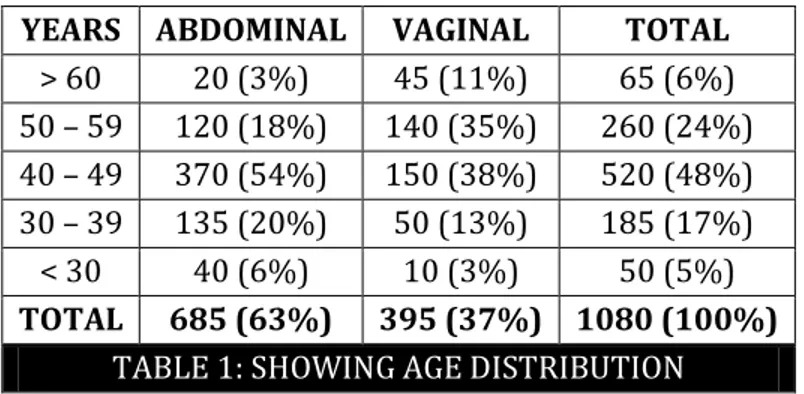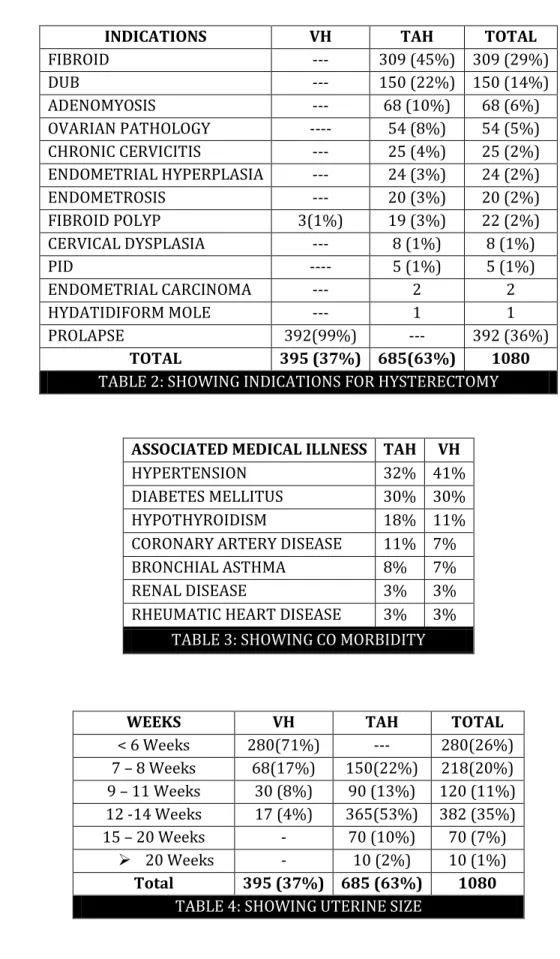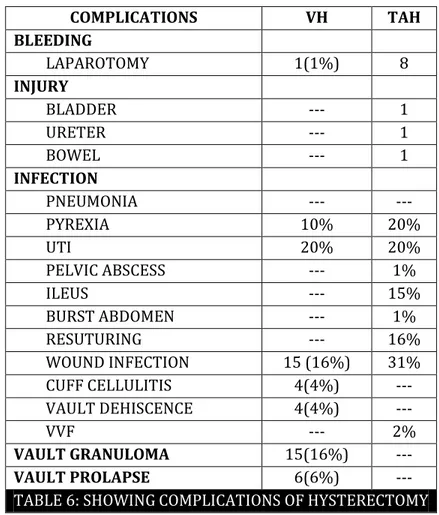J of Evolution of Med and Dent Sci/ eISSN- 2278-4802, pISSN- 2278-4748/ Vol. 3/ Issue 11/ Mar 17, 2014 Page 2768
RETROSPECTIVE STUDY OF TOTAL ABDOMINAL HYSTERECTOMY VERSUS
VAGINAL HYSTERECTOMY
Geetha K1, Seethalakshmi B2, Jamila Hameed3
HOW TO CITE THIS ARTICLE:
Geetha K, Seethalakshmi B, Jamila Hameed. Retrospective Study of Total Abdominal Hysterectomy versus Vaginal Hysterectomy . Journal of Evolution of Medical and Dental Sciences 2014; Vol. 3, Issue 11, March 17; Page: 2768-2773, DOI: 10.14260/jemds/2014/2207
ABSTRACT: INTRODUCTION: Hysterectomy is one of the commonly performed surgeries by the gynecologists apart from caesarean section for various benign and malignant gynecological problems pertaining to uterus, tubes and ovaries. Two major routes commonly performed are abdominal and vaginal hysterectomy apart from laparoscopic hysterectomy. OBJECTIVE: The purpose of this study was to find out frequency, indications, complications of Total abdominal hysterectomy (TAH) and vaginal hysterectomy (VH) done at Vinayaka Missions Medical College and Hospital, Karaikal and their impact on future. STUDY DESIGN: Historic cohort. MATERIALS AND METHODS: This is a retrospective study involving 1080 patients, 685 patients had TAH and 395 patients had VH between 2007 and 2012. The original case files and surgery reports were analyzed and data collected with reference to age, indication, parity, blood group, associated pelvic pathology and uterus size, co-morbidity, previous surgery, pre and post-operative transfusions, type of anesthesia, intra operative and post-operative complications, duration of hospital stay and the course of antibiotics. RESULTS: From our study we found that the morbidity for abdominal hysterectomy was more compared to vaginal hysterectomy for benign diseases in various aspects except for intra-operative blood loss which was more for vaginal hysterectomy in comparison with abdominal hysterectomy. The average duration of indwelling catheter was less in VH compared to TAH. There was no significant difference in the outcome with the type of anesthesia and the course of antibiotics. CONCLUSION: The overall complications for VH in selected cases were lesser than TAH which may suggest that VH may be an appropriate alternative to TAH.
KEYWORDS: Total abdominal hysterectomy, vaginal hysterectomy
INTRODUCTION: Hysterectomy is one of the commonly performed surgeries by the gynecologists, apart from caesarean section, for various benign and malignant gynecological problems pertaining to uterus, tubes and ovaries. Hysterectomy was first described by Soranus in a case of uterovaginal prolapse; he presumably performed amputation of cervix. In the sixteenth century an Italian, Berengario de Capri wrote about excision of uterine portion in prolapse of uterus. The first recorded operation was by Langenbeck, in the year 1825, who removed the uterus for advanced cervical malignancy. Two major routes commonly performed are abdominal and vaginal hysterectomy apart from laparoscopic hysterectomy. The commonest indication for TAH being fibroid uterus and prolapsed uterus for VH. Other indications are DUB, chronic cervicitis, adenomyosis, endometriosis and for malignancy.1 Nowadays VH is done for non-descent uterus for conditions like DUB,
J of Evolution of Med and Dent Sci/ eISSN- 2278-4802, pISSN- 2278-4748/ Vol. 3/ Issue 11/ Mar 17, 2014 Page 2769 OBJECTIVES: The aim of this study is to find out frequency, indications and complications of TAH versus VH done at Vinayaka Missions Medical College Hospital, Karaikal and their impact on future and to draw solid guide lines for selecting patients for TAH and VH.
MATERIAL AND METHODS: This is a study involving 1080 patients, 685 patients had TAH; 395 patients had VH between 2007 and 2012. The original case files and surgery reports were analyzed and data collected with reference to age, indication, parity, blood group, associated pelvic pathology and uterus size, co-morbidity, previous surgery, pre and post-operative transfusions, type of anesthesia, intra operative and post-operative complications, duration of hospital stay and the course of antibiotics.
STATISTICAL ANALYSIS: The analysis was performed using SPSS version 10. The frequency and percentage were computed or presentation of all variables. The chi-square test was used for calculating the p value applicable for complications of hysterectomy.
RESULTS: The mean age of the patient who had undergone hysterectomy was 58.5 + 12 years for vaginal and 44.69+7.9 years for abdominal hysterectomy. The parity of the patient in both groups were belonging to para 1-2 in majority. The complication rate in terms of pyrexia was 10% for VH and 20% for TAH with the p value of 0.05, postoperative wound infection of 31% for TAH and 16% for VH. The decrease in hematocrit was lower in TAH (2.39+1.05%) than in VH. Hospital stay was less for VH i.e. less than 4 days compared to 7 days for TAH.
In TAH, the youngest was 21 years, with tubo -ovarian mass and pyoperitoneum; history revealed laparotomy at 15 years of age for cryptomenorrhea and maldeveloped uterus. She developed subsequent endometriosis with PID treated elsewhere. The oldest patient was 70 years. In VH the youngest was 29 years and the oldest was 80 years. Majority of the patients in both groups were belonging to para 1 – 2. The foremost indication in TAH was fibroid uterus (45%). In VH it was mainly prolapse uterus (99%).Hypertension was 32% in TAH and 41% in VH. Diabetes was 30% in both groups. In VH 71% had uterine size less than 6 weeks; in TAH 53% it was between 12–14 wks.
YEARS ABDOMINAL VAGINAL TOTAL
> 60 20 (3%) 45 (11%) 65 (6%) 50 – 59 120 (18%) 140 (35%) 260 (24%) 40 – 49 370 (54%) 150 (38%) 520 (48%) 30 – 39 135 (20%) 50 (13%) 185 (17%) < 30 40 (6%) 10 (3%) 50 (5%) TOTAL 685 (63%) 395 (37%) 1080 (100%)
J of Evolution of Med and Dent Sci/ eISSN- 2278-4802, pISSN- 2278-4748/ Vol. 3/ Issue 11/ Mar 17, 2014 Page 2770
INDICATIONS VH TAH TOTAL
FIBROID --- 309 (45%) 309 (29%)
DUB --- 150 (22%) 150 (14%)
ADENOMYOSIS --- 68 (10%) 68 (6%)
OVARIAN PATHOLOGY ---- 54 (8%) 54 (5%) CHRONIC CERVICITIS --- 25 (4%) 25 (2%) ENDOMETRIAL HYPERPLASIA --- 24 (3%) 24 (2%)
ENDOMETROSIS --- 20 (3%) 20 (2%)
FIBROID POLYP 3(1%) 19 (3%) 22 (2%) CERVICAL DYSPLASIA --- 8 (1%) 8 (1%)
PID ---- 5 (1%) 5 (1%)
ENDOMETRIAL CARCINOMA --- 2 2
HYDATIDIFORM MOLE --- 1 1
PROLAPSE 392(99%) --- 392 (36%)
TOTAL 395 (37%) 685(63%) 1080
TABLE 2: SHOWING INDICATIONS FOR HYSTERECTOMY
ASSOCIATED MEDICAL ILLNESS TAH VH
HYPERTENSION 32% 41%
DIABETES MELLITUS 30% 30%
HYPOTHYROIDISM 18% 11%
CORONARY ARTERY DISEASE 11% 7% BRONCHIAL ASTHMA 8% 7%
RENAL DISEASE 3% 3%
RHEUMATIC HEART DISEASE 3% 3%
TABLE 3: SHOWING CO MORBIDITY
WEEKS VH TAH TOTAL
< 6 Weeks 280(71%) --- 280(26%) 7 – 8 Weeks 68(17%) 150(22%) 218(20%) 9 – 11 Weeks 30 (8%) 90 (13%) 120 (11%) 12 -14 Weeks 17 (4%) 365(53%) 382 (35%) 15 – 20 Weeks - 70 (10%) 70 (7%)
20 Weeks - 10 (2%) 10 (1%) Total 395 (37%) 685 (63%) 1080
J of Evolution of Med and Dent Sci/ eISSN- 2278-4802, pISSN- 2278-4748/ Vol. 3/ Issue 11/ Mar 17, 2014 Page 2771 Blood loss (ml) VH TAH Total
100-500 45 (11%) 474 (69%) 519 (48%) 500-1000 350 (89%) 211 (31%) 561 (52%)
Total 395 685 1080
TABLE 5: SHOWING BLOOD LOSS
In TAH 69% had blood loss between 100-500 ml. In VH 89% had blood loss of more than 500ml. Approximate duration of surgery was 60 – 80 minutes in TAH and 40 - 60 minutes in VH. The average duration of indwelling urinary catheter was longer in TAH. One of the patients had Foleys catheter for 25 days due to previous caesarian section. Catheter was in situ to avoid fistula formation. The course of antibiotics did not show any difference in both groups. Hospital stay was less in case of VH. In TAH 89% patients were discharged on the second week; in VH 96% were discharged within in 1 week. Post – operative complications were less in cases of VH.
COMPLICATIONS VH TAH
BLEEDING
LAPAROTOMY 1(1%) 8
INJURY
BLADDER --- 1
URETER --- 1
BOWEL --- 1
INFECTION
PNEUMONIA --- ---
PYREXIA 10% 20%
UTI 20% 20%
PELVIC ABSCESS --- 1%
ILEUS --- 15%
BURST ABDOMEN --- 1%
RESUTURING --- 16%
WOUND INFECTION 15 (16%) 31% CUFF CELLULITIS 4(4%) --- VAULT DEHISCENCE 4(4%) ---
VVF --- 2%
VAULT GRANULOMA 15(16%) ---
VAULT PROLAPSE 6(6%) ---
TABLE 6: SHOWING COMPLICATIONS OF HYSTERECTOMY
J of Evolution of Med and Dent Sci/ eISSN- 2278-4802, pISSN- 2278-4748/ Vol. 3/ Issue 11/ Mar 17, 2014 Page 2772 Our study shows that vaginal hysterectomy is superior to other routes taking into account the above said variables for benign disease without much complication. In order to control complications and decrease the morbidity, a high risk population should be defined based on the patients history of pelvic surgery and endometriosis, on their parity and the size of their uterus.2 In the study done by
Juha Makinen in 2001 complications like infections, hemorrhage and bowel injuries were more in vaginal hysterectomy group when compared to abdominal hysterectomy and also the author observed a decreasing trend of bowel complications with increasing experience of the surgeons in vaginal hysterectomy.3
Only one study done by Davies. A had shown that route of hysterectomy is not a major determining factor for perioperative complications when other compounding variables are taken into account.4 Large and comprehensive randomized controlled studies are badly needed to give answer
to these questions.
Our present study shows more of intraoperative bleeding for vaginal hysterectomy in quantity (500 to 1000 ml) that is 89% when compared to abdominal hysterectomy (31%) in contradictory to other studies done in Finland U.S.A, U.K., France and Saudi Arabia.5 This could be due
to increase in percentage of prolapse uterus particularly procidentia prevalent in our rural area. Evidence shows that transvaginal hysterectomy is both feasible and optimum for type of patients who have long been considered inappropriate for vaginal route even for uterus size upto 20 weeks6. Usage of newer instruments like Bulldog vulsellum and Biclamp facilitates vaginal approach
easier and contributes to improved hemostasis and decreased operative time.7 Though most of the
studies conducted confirm the superiority of the vaginal hysterectomy over abdominal hysterectomy, the incidence of abdominal hysterectomy versus vaginal is still more (3: 1).7 Even in our study out of
1080 patients 685 had TAH and 395 had VH (2: 1); it shows that presently the incidence of TAH is more than VH for benign diseases.
Over all our study confirms that vaginal hysterectomy is one of the promising routes of hysterectomy compared to abdominal hysterectomy in terms of shorter hospital stay, operating time, shorter convalescent period, decreased febrile morbidity etc. Study done by Dicker RC and Razia Iftikhar confirms the same.8, 9 Vaginal hysterectomies can be done for indications other than prolapse
uterus i.e. for fibroid up to 20 weeks without much complications.
May be in future Laparoscopic Hysterectomy can take an increase in frequency as the route of surgery for various gynecological indications with less morbidity as many surgeons are getting trained in this procedure in the recent past. Laparoscopic hysterectomy is associated with less pain and better quality of life than TAH.10
J of Evolution of Med and Dent Sci/ eISSN- 2278-4802, pISSN- 2278-4748/ Vol. 3/ Issue 11/ Mar 17, 2014 Page 2773 REFERENCES:
1. Nesa Asnafi. Comparison of complications in abdominal Hysterectomy versus vaginal Hysterectomy. J Reprod Infertil 2004; 5(4): 315-322.
2. Cosson M et al. Vaginal, Laparoscopic or abdominal hysterectomies for benign disorders: Immediate and early postoperative complications. Eur. J. Obstet Gynaecol Reprod. Biol. 2001; 98 (2): 231 – 6.
3. Makinen J. Morbidity of 10110 hysterectomies by type of approach. Hum. Reprod. 2001; 16 (7): 1473-8.
4. Davies A. Hysterectomy: Surgical route & complications. Eur J Obstet Gynaecol Reprod Biol. 2002; 104 (2): 148 – 51.
5. Al-Kadri H M. Short and long term complications of abdominal and vaginal hysterectomy for benign disease. Saudi Med J. 2002; 23 (7): 806 – 10.
6. Benassi L. Abdominal or vaginal hysterectomy for enlarged uteri: a randomised clinical trial. Am J Obstet Gynaecol. 2002; 187 (6): 1561 – 5.
7. Kovac SR. Transvaginal hysterectomy: Rationale and surgical approach. Obstet Gynaecol. 2004; 103 (6): 1321 – 5.
8. Dicker RC. Complications of abdominal and vaginal hysterectomy among women of reproductive age in the United States. The Collaborative Review of Sterilisation. Am J Obstet Gynaecol. 1982;144 (7):841-8.
9. Razia Iftikhar. Vaginal hysterectomy is superior than abdominal hysterectomy. Journal of Surgery Pakistan (International) 13 (2) 2008;55-58.
10.Garry R. The eVALuate study: two parallel randomised trials, one comparing laparoscopic with abdominal hysterectomy, the other comparing laparoscopic with vaginal hysterectomy BMJ 2004; 328 (7432): 129.
AUTHORS: 1. Geetha K. 2. Seethalakshmi B. 3. Jamila Hameed
PARTICULARS OF CONTRIBUTORS:
1. Assistant Professor, Department of Obstetrics and Gynaecology, Vinayaka Missions Medical Collage and Hospital, Karaikal, Pudhucherry, UT.
2. Lecturer, Department of Obstetrics and Gynaecology, Vinayaka Missions Medical Collage and Hospital, Karaikal, Pudhucherry, UT.
3. Professor, Department of Obstetrics and Gynaecology, Vinayaka Missions Medical Collage and Hospital, Karaikal, Pudhucherry, UT.
NAME ADDRESS EMAIL ID OF THE CORRESPONDING AUTHOR: Dr. K. Geetha,
Nandhu Clinic, 18/A,
Elaikara Street, Karaikal – 609602. E-mail: vemsrigeenan3@gmail.com


